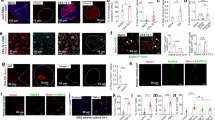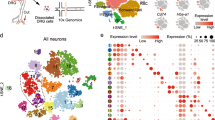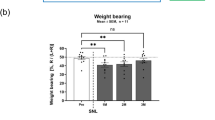Abstract
Peripheral neuropathic pain poses a significant global health challenge. Current drugs for peripheral neuropathic pain often fall short in efficacy or come with severe side effects, emphasizing the critical need for the development of highly effective and well-tolerated alternatives. Sophoricoside (SOP) is a nature product-derived isoflavone that possesses various pharmacological effects on inflammatory and neuropathy diseases. Here, in this study, analgesic effect was investigated by intrathecally administration of SOP/vehicle to spared nerve injury (SNI) or paclitaxel-induced peripheral neuropathic pain (PINP) rodent models, and mechanical allodynia was measured in Von Frey tests. Ipsilateral L4–L6 dorsal root ganglia (DRG) were used for protein expression. In silico molecular docking analysis was applied for assessing compound-target binding affinity. Primary cultured DRG neurons were utilized to investigate SOP’s effect on veratridine-triggered nociceptor activities and its selective inhibition of voltage-gated sodium channels subtype 1.6 (NaV1.6). The results showed SOP treatment alleviated mechanical allodynia in SNI and PINP rodent models (paw withdrawal threshold after 1 h of injection: SNI-vehicle: 1.385 ± 0.338 g; SNI-SOP: 9.963 ± 2.029 g, P < 0.001; PINP-vehicle: 5.040 ± 0.985 g; PINP-SOP: 8.287 ± 3.812 g, P = 0.004). SOP presented effects on both inhibiting veratridine-triggered nociceptor activities (oscillatory population: vehicle: 39.9 ± 7.3%; SOP: 30.7 ± 9.8%, P = 0.021) and selectively blocking NaV1.6 in DRG sensory neurons. Molecular docking analysis indicated direct binding between SOP and NaV1.6, leading to its endocytosis in DRG Sensory Neurons. In conclusion, SOP alleviated nociceptive allodynia induced by peripheral nerve injury via selectively blocking of NaV1.6 in DRG nociceptive neurons. we highlight its potential as an analgesic and elucidate its mechanism involving NaV1.6 endocytosis. This research opens avenues for exploring the analgesic effects of SOP and its potential impact on neuropathic pain therapy.
This is a preview of subscription content, access via your institution
Access options
Subscribe to this journal
Receive 13 print issues and online access
$259.00 per year
only $19.92 per issue
Buy this article
- Purchase on SpringerLink
- Instant access to full article PDF
Prices may be subject to local taxes which are calculated during checkout





Similar content being viewed by others
References
Dahlhamer J, Lucas J, Zelaya C, Nahin R, Mackey S, DeBar L, et al. Prevalence of chronic pain and high-impact chronic pain among adults—United States, 2016. MMWR Morb Mortal Wkly Rep. 2018;67:1001–1006. https://doi.org/10.15585/mmwr.mm6736a2.
Tsang A, Von Korff M, Lee S, Alonso J, Karam E, Angermeyer MC, et al. Common chronic pain conditions in developed and developing countries: gender and age differences and comorbidity with depression-anxiety disorders. J Pain. 2008;9:883–91. https://doi.org/10.1016/j.jpain.2008.05.005.
Elzahaf RA, Tashani OA, Unsworth BA, Johnson MI. The prevalence of chronic pain with an analysis of countries with a Human Development Index less than 0.9: a systematic review without meta-analysis. Curr Med Res Opin. 2012;28:1221–9. https://doi.org/10.1185/03007995.2012.703132.
Fornasari D. Pharmacotherapy for neuropathic pain: a review. Pain Ther. 2017;6:25–33. https://doi.org/10.1007/s40122-017-0091-4.
Haroutounian S, Nikolajsen L, Bendtsen TF, Finnerup NB, Kristensen AD, Hasselstrom JB, et al. Primary afferent input critical for maintaining spontaneous pain in peripheral neuropathy. Pain. 2014;155:1272–9. https://doi.org/10.1016/j.pain.2014.03.022
Bajaj S, Ong ST, Chandy KG. Contributions of natural products to ion channel pharmacology. Nat Prod Rep. 2020;37:703–16. https://doi.org/10.1039/c9np00056a
Cardoso FC, Lewis RJ. Sodium channels and pain: from toxins to therapies. Br J Pharmacol. 2018;175:2138–57. https://doi.org/10.1111/bph.13962
Xu H, Li T, Rohou A, Arthur CP, Tzakoniati F, Wong E, et al. Structural basis of Nav1.7 inhibition by a gating-modifier spider toxin. Cell. 2019;176:702–715.e714. https://doi.org/10.1016/j.cell.2018.12.018
Cummins TR, Dib-Hajj SD, Herzog RI, Waxman SG. Nav1.6 channels generate resurgent sodium currents in spinal sensory neurons. FEBS Lett. 2005;579:2166-70 https://doi.org/10.1016/j.febslet.2005.03.009.
Xie W, Strong JA, Ye L, Mao JX, Zhang JM. Knockdown of sodium channel NaV1.6 blocks mechanical pain and abnormal bursting activity of afferent neurons in inflamed sensory ganglia. Pain. 2013;154:1170–80. https://doi.org/10.1016/j.pain.2013.02.027.
Xie W, Strong JA, Zhang JM. Local knockdown of the NaV1.6 sodium channel reduces pain behaviors, sensory neuron excitability, and sympathetic sprouting in rat models of neuropathic pain. Neuroscience. 2015;291:317–30. https://doi.org/10.1016/j.neuroscience.2015.02.010.
Tanaka BS, Zhao P, Dib-Hajj FB, Morisset V, Tate S, Waxman SG, et al. A gain-of-function mutation in Nav1.6 in a case of trigeminal neuralgia. Mol Med. 2016;22:338–48. https://doi.org/10.2119/molmed.2016.00131.
Chen L, Huang J, Zhao P, Persson A-K, Dib-Hajj FB, Cheng X, et al. Conditional knockout of NaV1.6 in adult mice ameliorates neuropathic pain. Sci Rep. 2018;8:3845. https://doi.org/10.1038/s41598-018-22216-w
Li L, Shao J, Wang J, Liu Y, Zhang Y, Zhang M, et al. MiR-30b-5p attenuates oxaliplatin-induced peripheral neuropathic pain through the voltage-gated sodium channel Nav1.6 in rats. Neuropharmacology. 2019;153:111–20. https://doi.org/10.1016/j.neuropharm.2019.04.024.
Khan FA, Ali G, Rahman K, Khan Y, Ayaz M, Mosa OF, et al. Efficacy of 2-hydroxyflavanone in rodent models of pain and inflammation: involvement of opioidergic and GABAergic anti-nociceptive mechanisms. Molecules. 2022;27. https://doi.org/10.3390/molecules27175431.
Khatoon F, Ali S, Kumar V, Elasbali AM, Alhassan HH, Alharethi SH, et al. Pharmacological features, health benefits and clinical implications of honokiol. J Biomol Struct Dyn. 2023;41:7511–33. https://doi.org/10.1080/07391102.2022.2120541.
Friedrich L, Cingolani G, Ko YH, Iaselli M, Miciaccia M, Perrone MG, et al. Learning from nature: from a marine natural product to synthetic cyclooxygenase-1 inhibitors by automated de novo design. Adv Sci. 2021;8:e2100832. https://doi.org/10.1002/advs.202100832.
Wu YX, Zeng S, Wan BB, Wang YY, Sun HX, Liu G, et al. Sophoricoside attenuates lipopolysaccharide-induced acute lung injury by activating the AMPK/Nrf2 signaling axis. Int Immunopharmacol. 2021;90:107187. https://doi.org/10.1016/j.intimp.2020.107187.
Wang H, He D, Li Z, Gao X, Yang S, Cui M, et al. Oral administration of sophoricoside (SOP) inhibits neuronal damage and neuroinflammation to curb neurodegeneration in Parkinson’s disease. Chem Biol Interact. 2023;384:110726. https://doi.org/10.1016/j.cbi.2023.110726.
Decosterd I, Woolf CJ. Spared nerve injury: an animal model of persistent peripheral neuropathic pain. Pain. 2000;87:149–58. https://doi.org/10.1016/S0304-3959(00)00276-1.
Li Y, North RY, Rhines LD, Tatsui CE, Rao G, Edwards DD, et al. DRG voltage-gated sodium channel 1.7 is upregulated in paclitaxel-induced neuropathy in rats and in humans with neuropathic pain. J Neurosci. 2018;38:1124–36. https://doi.org/10.1523/JNEUROSCI.0899-17.2017.
Chaplan SR, Bach FW, Pogrel JW, Chung JM, Yaksh TL. Quantitative assessment of tactile allodynia in the rat paw. J Neurosci Methods. 1994;53:55–63. https://doi.org/10.1016/0165-0270(94)90144-9.
Yang H, Shan Z, Guo W, Wang Y, Cai S, Li F, et al. Reversal of peripheral neuropathic pain by the small-molecule natural product narirutin via block of Na(v)1.7 voltage-gated sodium channel. Int J Mol Sci. 2022;23. https://doi.org/10.3390/ijms232314842.
Cai S, Moutal A, Yu J, Chew LA, Isensee J, Chawla R, et al. Selective targeting of NaV1.7 via inhibition of the CRMP2-Ubc9 interaction reduces pain in rodents. Sci Transl Med. 2021;13:eabh1314. https://doi.org/10.1126/scitranslmed.abh1314.
Cai S, Bellampalli SS, Yu J, Li W, Ji Y, Wijeratne EMK, et al. (-)-Hardwickiic acid and hautriwaic acid induce antinociception via blockade of Tetrodotoxin-sensitive voltage-dependent sodium channels. ACS Chem Neurosci. 2019;10:1716–28. https://doi.org/10.1021/acschemneuro.8b00617.
Rosker C, Lohberger B, Hofer D, Steinecker B, Quasthoff S, Schreibmayer W. The TTX metabolite 4,9-anhydro-TTX is a highly specific blocker of the Na(v1.6) voltage-dependent sodium channel. Am J Physiol Cell Physiol. 2007;293:C783–789. https://doi.org/10.1152/ajpcell.00070.2007.
Liu Z, Shan Z, Yang H, Xing Y, Guo W, Cheng J, et al. Quercetin, main active ingredient of Moutan Cortex, alleviates chronic orofacial pain via block of voltage-gated sodium channel. Anesth Analg. 2023. https://doi.org/10.1213/ANE.0000000000006730.
Wu C, Luan H, Wang S, Zhang X, Wang R, Jin L, et al. Modulation of lipogenesis and glucose consumption in HepG2 cells and C2C12 myotubes by sophoricoside. Molecules. 2013;18:15624–35. https://doi.org/10.3390/molecules181215624.
Li W, Lu Y. Hepatoprotective effects of sophoricoside against fructose-induced liver injury via regulating lipid metabolism, oxidation, and inflammation in mice. J Food Sci. 2018;83:552–8. https://doi.org/10.1111/1750-3841.14047.
Xu L, Ding X, Wang T, Mou S, Sun H, Hou T. Voltage-gated sodium channels: structures, functions, and molecular modeling. Drug Discov Today. 2019;24:1389–97. https://doi.org/10.1016/j.drudis.2019.05.014.
Eijkenboom I, Sopacua M, Hoeijmakers JGJ, de Greef BTA, Lindsey P, Almomani R, et al. Yield of peripheral sodium channels gene screening in pure small fibre neuropathy. J Neurol Neurosurg Psychiatry. 2019;90:342–52. https://doi.org/10.1136/jnnp-2018-319042.
Mohammed ZA, Doran C, Grundy D, Nassar MA. Veratridine produces distinct calcium response profiles in mouse dorsal root ganglia neurons. Sci Rep. 2017;7:45221. https://doi.org/10.1038/srep45221
Mohammed ZA, Kaloyanova K, Nassar MA. An unbiased and efficient assessment of excitability of sensory neurons for analgesic drug discovery. Pain. 2020;161:1100–8. https://doi.org/10.1097/j.pain.0000000000001802
Rush AM, Cummins TR, Waxman SG. Multiple sodium channels and their roles in electrogenesis within dorsal root ganglion neurons. J Physiol. 2007;579:1–14. https://doi.org/10.1113/jphysiol.2006.121483.
Finnerup NB, Attal N, Haroutounian S, McNicol E, Baron R, Dworkin RH, et al. Pharmacotherapy for neuropathic pain in adults: a systematic review and meta-analysis. Lancet Neurol. 2015;14:162–73. https://doi.org/10.1016/S1474-4422(14)70251-0.
Finnerup NB, Kuner R, Jensen TS. Neuropathic pain: from mechanisms to treatment. Physiol Rev. 2021;101:259–301. https://doi.org/10.1152/physrev.00045.2019.
Zhao J, Luo D, Liang Z, Lao L, Rong J. Plant natural product puerarin ameliorates depressive behaviors and chronic pain in mice with spared nerve injury (SNI). Mol Neurobiol. 2017;54:2801–12. https://doi.org/10.1007/s12035-016-9870-x.
Woodbury A, McCrary MR, Yu SP. Molecular targets and natural compounds in drug development for the treatment of inflammatory pain. Curr Drug Targets. 2018;19:1905–15. https://doi.org/10.2174/1389450119666180514120438.
Taha O, Opitz T, Mueller M, Pitsch J, Becker A, Evert BO, et al. Neuropathic pain in experimental autoimmune neuritis is associated with altered electrophysiological properties of nociceptive DRG neurons. Exp Neurol. 2017;297:25–35. https://doi.org/10.1016/j.expneurol.2017.07.011.
Deuis JR, Zimmermann K, Romanovsky AA, Possani LD, Cabot PJ, Lewis RJ, et al. An animal model of oxaliplatin-induced cold allodynia reveals a crucial role for Nav1.6 in peripheral pain pathways. Pain. 2013;154:1749–57. https://doi.org/10.1016/j.pain.2013.05.032.
Sittl R, Lampert A, Huth T, Schuy ET, Link AS, Fleckenstein J, et al. Anticancer drug oxaliplatin induces acute cooling-aggravated neuropathy via sodium channel subtype Na(V)1.6-resurgent and persistent current. Proc Natl Acad Sci USA. 2012;109:6704–9. https://doi.org/10.1073/pnas.1118058109.
Laedermann CJ, Cachemaille M, Kirschmann G, Pertin M, Gosselin RD, Chang I, et al. Dysregulation of voltage-gated sodium channels by ubiquitin ligase NEDD4-2 in neuropathic pain. J Clin Investig. 2013;123:3002–13. https://doi.org/10.1172/JCI68996.
Goodchild SJ, Shuart NG, Williams AD, Ye W, Parrish RR, Soriano M, et al. Molecular pharmacology of selective NaV1.6 and dual NaV1.6/NaV1.2 channel inhibitors that suppress excitatory neuronal activity ex vivo. ACS Chem Neurosci. 2024;15:1169–84. https://doi.org/10.1021/acschemneuro.3c00757.
Johnson JP, Focken T, Khakh K, Tari PK, Dube C, Goodchild SJ, et al. NBI-921352, a first-in-class, NaV1.6 selective, sodium channel inhibitor that prevents seizures in Scn8a gain-of-function mice, and wild-type mice and rats. eLife. 2022;11:e72468. https://doi.org/10.7554/eLife.72468.
Funding
This work was supported by the National Natural Science Foundation of China, Grant No. 82201376 and the Natural Science Foundation of Guangdong Province, Grant No. 2021A1515011129.
Author information
Authors and Affiliations
Contributions
Conceptualization, WG, ZS, and SC; data acquisition and analysis: animal model, XC and QX; behavior test, WG and TL; electrophysiological recording, WG, HY, and YW; molecular docking, DZ; manuscript drafting, YP, ZS, and SC. All authors have read and agreed to the published version of the manuscript.
Corresponding authors
Ethics declarations
Competing interests
The authors declare no competing interests.
Additional information
Publisher’s note Springer Nature remains neutral with regard to jurisdictional claims in published maps and institutional affiliations.
Supplementary information
Rights and permissions
Springer Nature or its licensor (e.g. a society or other partner) holds exclusive rights to this article under a publishing agreement with the author(s) or other rightsholder(s); author self-archiving of the accepted manuscript version of this article is solely governed by the terms of such publishing agreement and applicable law.
About this article
Cite this article
Guo, W., Yang, H., Wang, Y. et al. Small-molecule natural product sophoricoside reduces peripheral neuropathic pain via directly blocking of NaV1.6 in dorsal root ganglion nociceptive neurons. Neuropsychopharmacol. 50, 662–672 (2025). https://doi.org/10.1038/s41386-024-01998-w
Received:
Revised:
Accepted:
Published:
Issue date:
DOI: https://doi.org/10.1038/s41386-024-01998-w



